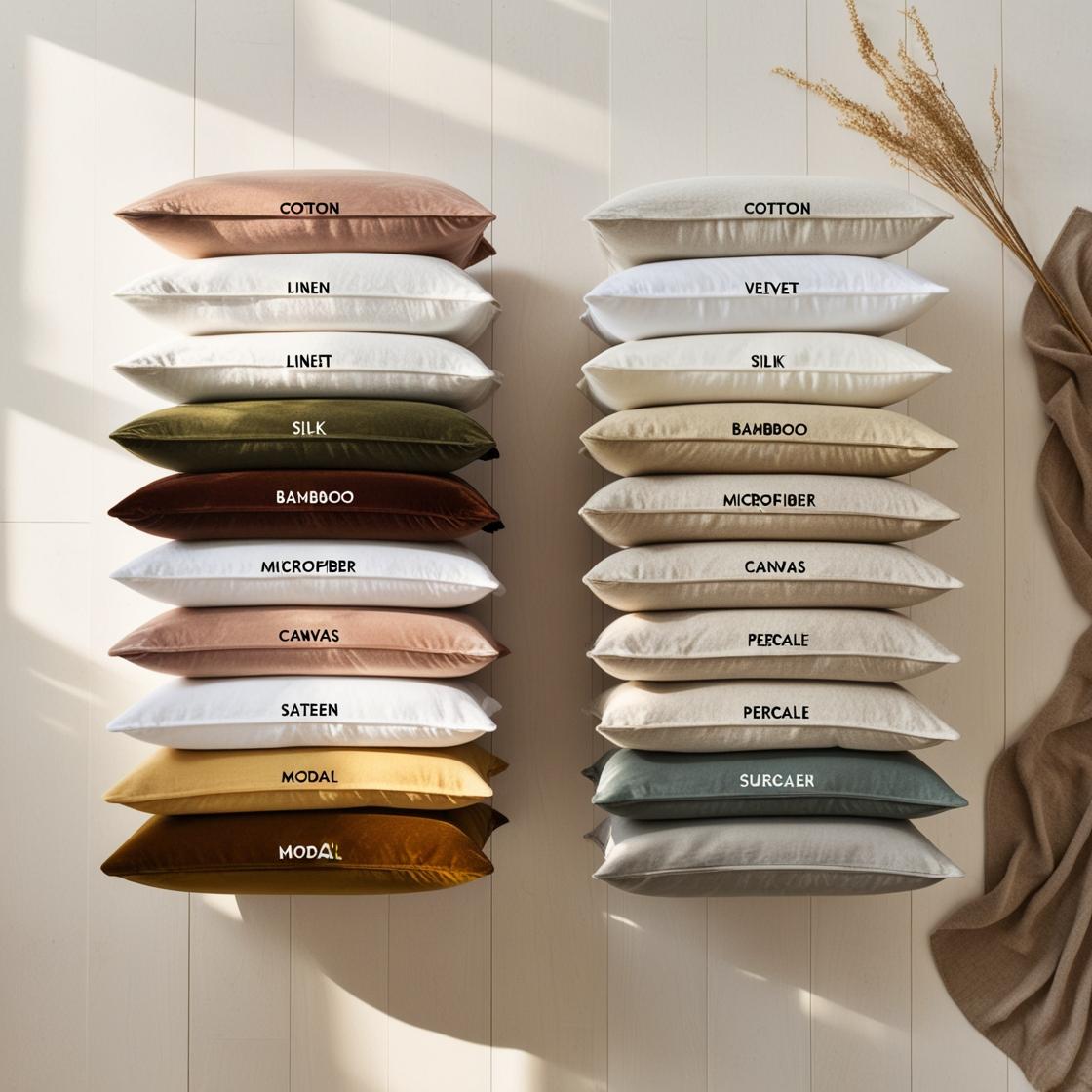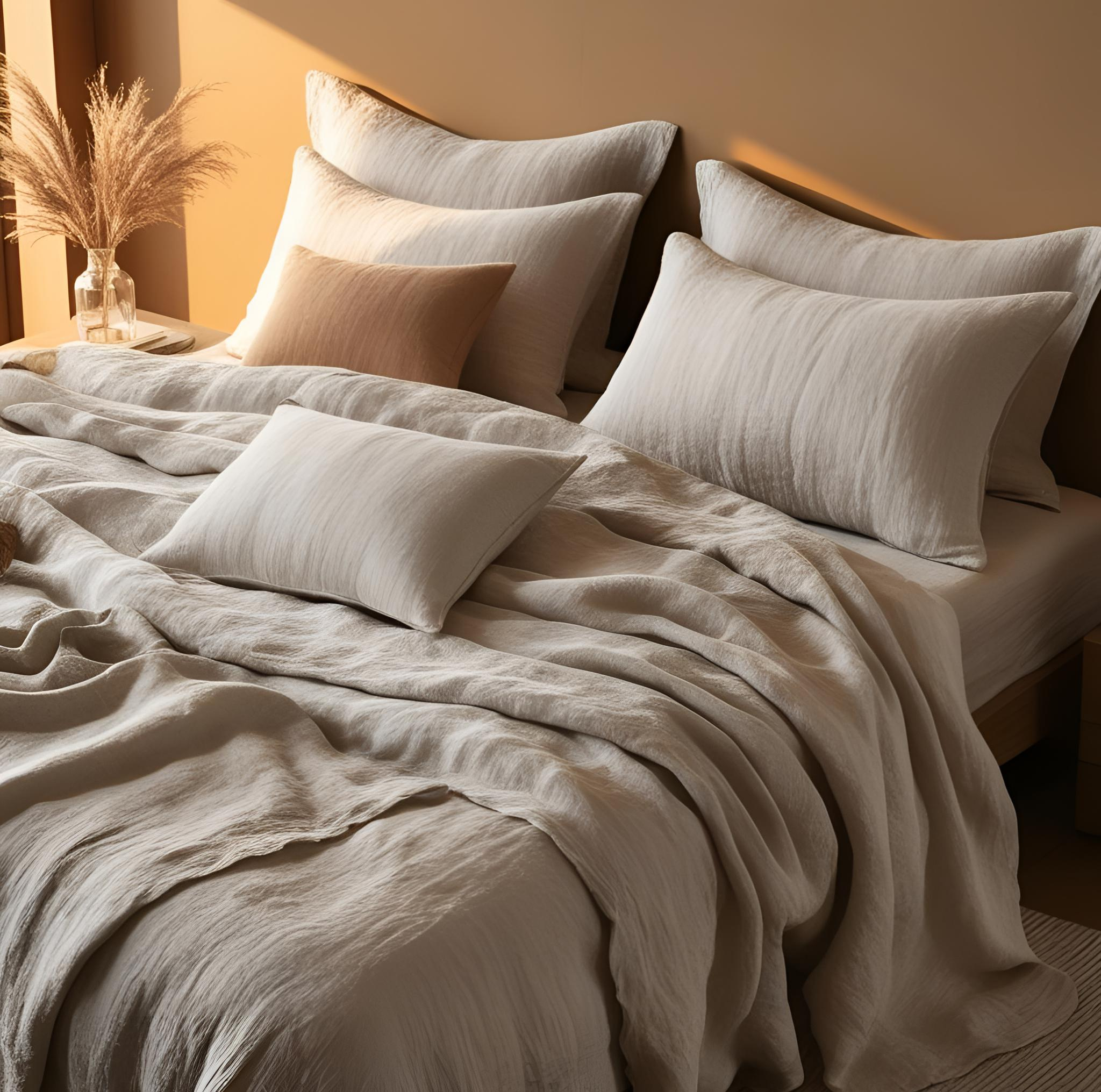Your pillowcases are more than just aesthetics; they’re your home's secret superstars that endure late-night reading sessions, coffee splashes, and the occasional catnap. Choosing the best fabric for pillow covers is all about seeking a balance of durability and coziness, good looks, and function. So, meet the backstories of superstar fabrics, which transform boring pillows into life companions, each distinct in its characteristics and utility.
1. Cotton: The Evergreen Essential
Cotton is the Swiss Army knife of comfortable pillow cover materials, a democratic fabric that suits farmhouse charm and minimalist lofts alike. Imagine crisp percale cotton, its tight weave offering a hotel-bed finish, or buttery sateen that begs for weekend lounging. Egyptian and Supima cotton reign supreme here; their extra-long fibers resist pilling, surviving hundreds of washes while staying silky-soft. Allergy sufferers adore its hypoallergenic nature, while parents of messy toddlers worship its machine-washable ease. For a textural twist, pair organic cotton with linen accents. The duo softens beautifully over time, like a well-loved novel, and organic options cater to eco-conscious homes. Just avoid low-thread-count blends; they’ll fray faster than your patience on a Monday morning.

2. Linen: Nature’s Relaxed Muse
In the debate on linen vs. cotton for pillow covers, linen wins hearts with its lived-in luxe aesthetic. Made from resilient flax fibers, this fabric is 30% stronger than cotton, softening gracefully into a rumpled charm that whispers of sun-drenched Tuscan villas. Its loose weave lets air pirouette through, making it the MVP of humid climates—no sweaty backs during summer movie marathons. Eco-warriors cheer its low-water footprint and biodegradable nature, while design enthusiasts layer it against sleek leather sofas. Yes, it wrinkles. Embrace it.
3. Silk: The Gentle Glamour
For luxury fabric pillowcases USA aficionados, 22–25 momme mulberry silk is the holy grail. Slip into bed, and your skin glides over a surface so smooth, you’ll wake up without a single crease or frizz halo. High momme weights resist snags, though they demand the TLC of hand-washing in pH-neutral soap. Jewel tones like emerald or sapphire transform beds into art installations, while silk-linen blends offer a low-maintenance compromise for the opulence-curious. It’s not just for bedrooms; a single silk throw pillow in burnt orange can elevate a drab sofa to gallery-worthy status.
4. Velvet: Plush Opulence
Velvet, once reserved for Tudor monarchs, now reigns as the best fabric for decorative pillows in modern homes. Don’t let its plush exterior fool you; polyester-blended velvet hides wine spills like a seasoned spy and bounces back from puppy paws or toddler acrobatics. Deep burgundies and metallics add Old Hollywood drama to sectionals, while cotton-backed versions keep things breathable. Yes, it attracts lint like a magnet, but a quick swipe with a velvet brush restores its regal sheen. For outdoor spaces, opt for solution-dyed acrylic velvet; it laughs at UV rays and monsoon rains. Just avoid placing it in direct sunlight unless you want a fade-induced identity crisis.

5. Polyester Blends: Modern-Day Marvels
Polyester, the underdog of fabrics, has evolved into the most durable fabric for pillow covers, especially for households with kids, pets, or a penchant for red wine. Modern blends mimic linen’s texture or silk’s sheen while shrugging off stains and UV damage. Recycled PET versions turn plastic bottles into guilt-free plushness, perfect for sunrooms or homes with overenthusiastic golden retrievers. For sewing newbies, take note: Polyester-cotton blends resist fraying, making them ideal for handmade cushion covers that survive first attempts. While purists may scoff, innovations like moisture-wicking CoolTech finishes make it a sleeper hit for hot sleepers.
6. Eco-Warriors: Earth’s Resilient Allies
Hemp and Tencel are rising stars in eco-friendly fabric for pillow covers. Hemp, cousin to the flax plant, boasts rugged fibers that soften with each wash, outlasting trends and toddlers alike. It’s naturally antimicrobial, perfect for allergy sufferers, and thrives in sunny spots without fading. Tencel, derived from eucalyptus, offers silk’s smoothness with a fraction of the environmental guilt. Pair these with plant-based dyes (think indigo or turmeric), and you’ve got pillows that soothe both your conscience and your skin. Bonus: They compost gracefully, leaving no trace once retired.
7. Microfiber: Stain-Repelling Hero
Microfiber, the unsung hero of easy-to-clean pillow cover fabric, thrives in households where spills and pets reign. This tightly woven synthetic mimics suede’s softness but laughs off ketchup splatters and paw prints. Its moisture-resistant surface repels liquids long enough for you to grab a paper towel, and it dries faster than you can say “oops.” Opt for brushed microfiber for a velvety feel or textured weaves that hide wear. While not as breathable as natural fibers, innovations like perforated microfiber improve airflow. Bonus: It’s budget-friendly, making it ideal for seasonal decor swaps or DIY pillow projects.
8. Recycled Polyester: Green Without Compromise
Transforming discarded bottles into plush fabrics, recycled polyester offers easy-to-clean pillow cover fabric with a conscience. Its fade-resistant colors and wrinkle-free nature thrive in sunrooms or kids’ play areas. Advanced weaving techniques mimic linen’s texture or velvet’s sheen, proving sustainability doesn’t sacrifice style. Pair geometric-printed recycled polyester pillows with organic cotton throws for contrast that’s both bold and responsible.
9. Faux Fur: Cozy Extravagance
For those craving tactile luxury, faux fur delivers soft, breathable fabric for throw pillows without ethical dilemmas. Modern iterations use recycled fibers and hypoallergenic fills, making them kinder to sensitive skin and the planet. From snowy whites to bold leopard skin prints, these pillows add instant warmth to mid-century modern or glam decor. Spot-clean spills promptly, and fluff regularly to maintain their lavish pile, a small price for year-round snuggle.

10. Performance Fabrics: Weatherproof Warriors
For patio loungers or houses experiencing hurricane-level action, performance materials such as Sunbrella or Crypton are the most durable fabrics for pillow covers. They're UV, mold, and stain-resistant but have a remarkably soft hand feel. Crypton's spill-resistant barrier keeps drips at bay like a force field, and Sunbrella's fade-defying colors retain their color year after year. Apply them to patio pillows or playrooms; they'll outlast sunscreen smudges, mud, and monsoon showers. Though more expensive, their durability makes them a wise investment for high-traffic areas. Combine geometric Sunbrella patterns with wicker furnishings for a refined, hassle-free outdoor retreat.
Conclusion
Selecting the best fabric for pillow covers is like casting actors for a play. Cotton's the dependable star, linen the offbeat best friend, silk the diva drama queen, velvet the brooding artist, and polyester the understudy scene-stealer. Adorning a minimalist studio or a maximalist den, let your fabrics tell your story, one that ripens with refinement, withstands life's storms, and maybe even becomes a family heirloom. Combine textures boldly: a velvet lumbar pillow with a linen sofa, or a silk accent with cotton throws. Think about it, the best homes aren't designed; they're lived in, loved, and sometimes spilled on.
FAQs: The Pillow Cover Confessionals
1. Can I use velvet pillow covers in a sunny room without fading?
Opt for solution-dyed velvet; it’s UV-resistant and laughs at sunlight. Pair with blackout curtains for extra insurance.
2. Are there soft, breathable fabrics for throw pillows that repel pet hair?
Tightly woven linen-cotton blends resist fur better than loose weaves. Keep a lint roller handy for quick touch-ups.
3. How do I revive flattened velvet pillows?
Use a fabric steamer and a soft-bristle brush. Gently steam, then brush in the direction of the pile to resurrect its plushness.
4. Is hemp fabric scratchy for natural fabric pillow covers?
Initially, yes, but it softens dramatically with washes. Think of it like denim; it gets better with age and use.
5. Can I mix silk and polyester pillow covers without clashing?
Absolutely, use silk for solid colors and polyester for patterns. The shared sheen creates cohesion, while differing textures add depth.


